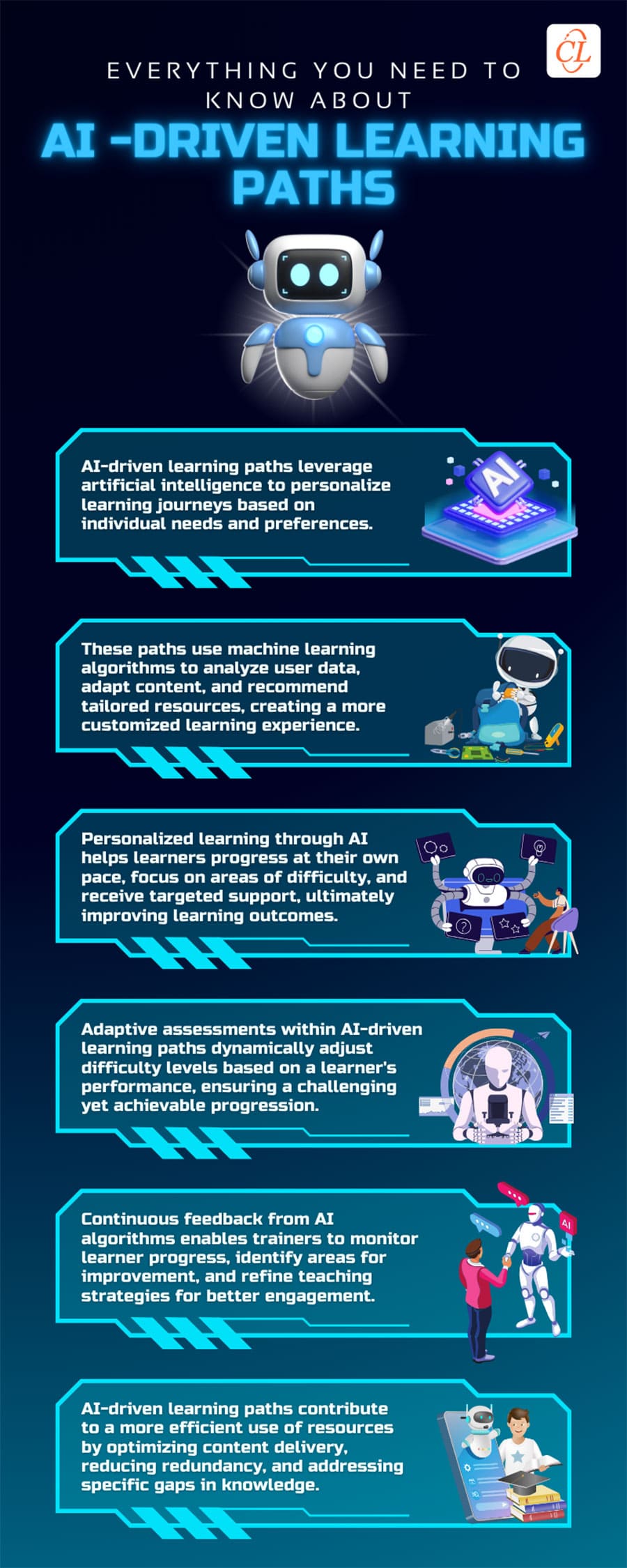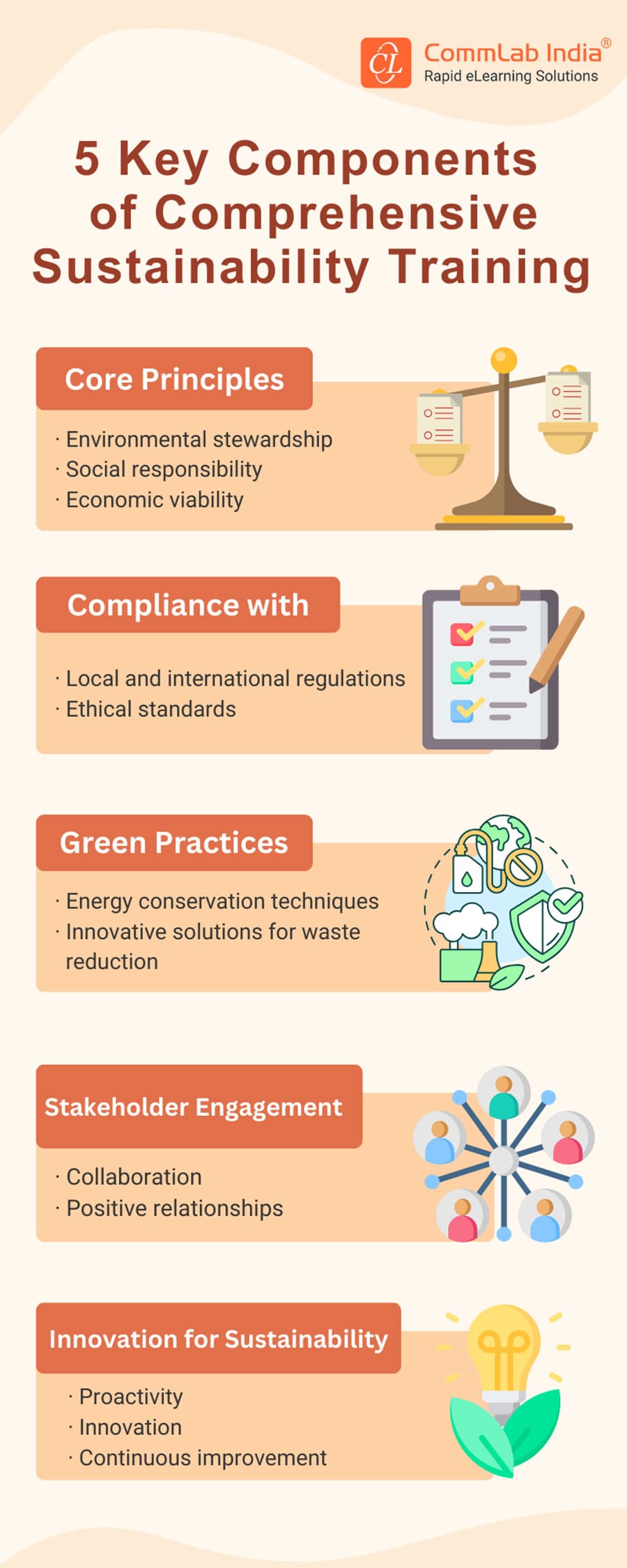Top L&D Trends to Watch Out for in 2025

As we approach 2025, Learning & Development (L&D) is undergoing transformative changes, the digital age, accelerated by the global pandemic, has redefined how we learn, adapt, and grow professionally. Personalized learning paths, AI integration, and tech-driven approaches are reshaping professional growth. Organizations are recognizing that staying competitive requires continuous skill development, making L&D a strategic priority.
→ Download eBook: Corporate L&D Trends 2025 – Get the View from the Trenches
Key trends include the rise of adaptive learning technologies, AI-powered platforms that customize training to individual needs, and microlearning. Remote and hybrid learning models remain prominent, supported by virtual reality (VR) and immersive technologies that enhance engagement and real-world application. Additionally, data analytics are increasingly being used to measure learning impact and drive continuous improvement.
Table of Content
- How is L&D Evolving?
- What are the Top L&D Trends to Watch in 2025?
- What is the Future of L&D in Preparing for a Hybrid Workforce?
How is L&D Evolving?
L&D has always been a key pillar for organizational growth. However, the methodologies have evolved drastically from traditional classroom training sessions to more modern, digital-first approaches. This shift is driven by changing workforce demographics, rapid technological advancements, and the need for continuous learning to stay relevant.
In past, we’ve seen L&D move from structured, formal learning to more flexible, on-demand, and blended learning environments. The integration of digital tools, cloud technologies, and AI is not only making learning accessible but also more engaging, measurable, and personalized. Let’s explore the top trends that will shape L&D in 2025.
What are the Top L&D Trends to Watch in 2025?
Are You Future Ready?
Explore What 2025 Has in Store for L&D:
- AI-driven Personalized Learning Paths
- AI and Machine Learning in L&D
- Microlearning and Bite-Sized Content
- Immersive Learning Technologies (AR/VR)
- And more!
1. AI-driven Personalized Learning Paths
Artificial intelligence (AI) is transforming corporate training by enabling personalized learning experiences for employees. Employees today expect learning experiences that are tailored to their individual needs. A "one-size-fits-all" approach no longer works. In 2025, we expect personalized learning paths to become the norm.
Through advanced analytics and AI-driven platforms, L&D departments will be able to design custom learning experiences based on the learners' role, skills gaps, and career aspirations.
Customized learning plans can incorporate a variety of formats, including video, quizzes, simulations, and self-assessment tools. These plans empower employees to learn at their own pace and retain knowledge more effectively.
AI-driven platforms analyze learner data to create tailored training programs that cater to individual needs and preferences. This level of personalization ensures that employees receive relevant and engaging content, leading to improved retention and performance.
By integrating AI into corporate training, organizations can optimize employee development and boost overall productivity. With AI in corporate training, employees can access content that aligns with their learning style, making the learning process more efficient and enjoyable.
Here’s an infographic to learn how AI is revolutionizing personalized learning paths.
2. AI and Machine Learning in L&D
Artificial Intelligence (AI) and Machine Learning (ML) are revolutionizing various industries, and Learning and Development (L&D) is no exception. These technologies are not just enhancing learning experiences; they are fundamentally transforming how learning is approached and delivered.
Key benefits of AI and ML in L&D include:
- Personalized Learning Paths: AI can analyze vast amounts of learning data to provide insights on program effectiveness, suggesting tailored learning paths based on individual needs, preferences, and progress. This customization enhances engagement and improves retention by delivering content suited to each learner's understanding.
- Streamlined Administrative Tasks: By automating processes such as tracking learner progress, scheduling training sessions, and grading assessments, AI allows trainers to focus more on training. This automation saves time and ensures learners receive timely updates on their performance, facilitating targeted improvement.
Looking ahead to 2025, we can expect further advancements in adaptive learning environments, which will:
- Use AI algorithms to dynamically adjust course materials based on real-time feedback from learners’ performance.
- Ensure that learning content remains both challenging and achievable, promoting continuous growth.
Additionally, AI-powered chatbots will emerge as vital virtual learning assistants, offering:
- Immediate feedback and answers to learners' questions during their studies.
- Enhanced interactivity, making the learning experience more responsive to individual needs.
Watch this video to delve deep into the world of AI and machine learning for corporate L&D.
3. Gamification in Learning
Gamification is one of the most effective strategies for boosting learner engagement. By incorporating game mechanics—such as points, badges, leaderboards, and challenges—into training programs, organizations can motivate employees to complete courses and retain information more effectively. This fun approach not only enhances the learning experience but also fosters a sense of accomplishment.
In 2025, we can expect gamified learning platforms to become even more sophisticated. These advancements will likely include personalized rewards, competitive challenges, and enhanced social interaction features, making learning not only enjoyable but rewarding as well.
The benefits of gamification in learning environments include:
- Increased Engagement: Game-like elements keep learners interested and motivated.
- Enhanced Retention: Interactive challenges help reinforce knowledge and improve memory.
- Immediate Feedback: Points and leaderboards provide instant recognition of progress.
4. Microlearning and Bite-Sized Content
As the attention spans of modern learners shrink and work schedules get busier, microlearning will dominate L&D strategies in 2025. Microlearning involves delivering short, focused bursts of content, typically 5-10 minutes long, that learners can quickly consume and apply in real time experiences.
These bite-sized lessons are particularly effective for mobile learning and are ideal for reinforcing knowledge through repetition. Platforms that support microlearning will be widely adopted, allowing learners to access training modules anytime, anywhere.
Here’s a concise overview of the trending microlearning formats for 2025.

5. The Growing Importance of Social Learning
Social learning is a trend that emphasizes the importance of learning through collaboration and interaction with peers. By incorporating social learning in corporate training programs, organizations can create a supportive learning environment that encourages employees to share knowledge, exchange ideas, and learn from one another.
Platforms like Slack and Microsoft Teams facilitate social learning by providing employees with the tools they need to communicate and collaborate effectively. By fostering a culture of social learning, organizations can enhance employee engagement, improve knowledge retention, and drive innovation across the workforce.
Social learning:
- Enhances employee engagement by fostering collaboration and interaction.
- Improves knowledge retention through peer-to-peer learning.
- Encourages idea exchange, leading to innovative solutions.
- Creates a supportive learning environment that boosts morale.
- Increases adaptability by equipping employees with diverse perspectives.
- Reduces training costs by leveraging existing employee expertise.
- Strengthens team dynamics and builds a sense of community.

Corporate L&D Trends 2025
Get the View from the Trenches
- Win with AI
- Design for the agile workforce
- Unlock scale, volume, quality
- Make an impact
- Much more
6. Shift Towards Unstructured, Nonlinear Learning for Gen Z
As Gen Z enters the workforce, corporate training programs must adapt to the learning preferences of this digitally native generation. Gen Z learners prefer unstructured, nonlinear learning experiences that allow them to explore topics at their own pace and according to their interests. This shift towards a more flexible learning approach encourages creativity and critical thinking, fostering a deeper understanding of the subject matter.
Organizations can cater to Gen Z's learning preferences by offering diverse learning resources, such as podcasts, webinars, and interactive simulations. By providing a range of learning options, companies can empower Gen Z employees to take control of their learning journey and develop the skills they need to succeed in their careers.
Discover GenZ's secret weapon in training - Microlearning! Watch this video to understand that microlearning is not just a trend, but a revolutionary method, specially tailored for the dynamic needs of the Gen Z learners.
7. Virtual Reality (VR) and Augmented Reality (AR) in Corporate Training
Virtual reality (VR) and augmented reality (AR) are emerging technologies that have the potential to revolutionize corporate training by providing immersive and interactive learning experiences. VR and AR can simulate real-world scenarios, allowing employees to practice skills and apply knowledge in a safe and controlled environment.
Companies like Walmart and Boeing are already leveraging VR and AR in their training programs, resulting in improved employee performance and reduced training costs. By incorporating VR and AR into corporate training, organizations can enhance the learning experience, increase engagement, and ensure employees are well-prepared for real-world challenges.
Here’s a quick video exploring how these technologies are transforming the way companies train their employees, making learning more immersive, interactive, and effective.
8. AI-Driven Analytics for Continuous Improvement
AI-driven analytics are playing a crucial role in corporate training by providing valuable insights into employee performance and learning outcomes. By leveraging AI-powered analytics, organizations can identify areas for improvement and optimize their training programs to better meet the needs of their workforce.
Platforms like Learning Management Systems (LMS) and AI-powered analytics tools can track employee progress, measure engagement, and evaluate the effectiveness of training programs. By using AI-driven analytics, organizations can continuously improve their training programs, ensuring that employees receive the support they need to develop their skills and advance in their careers.
9. Mobile Learning for On-the-Go Training
Mobile learning is a crucial trend in corporate training, allowing employees to access learning materials anytime, anywhere, through their smartphones or tablets. This flexible approach meets the demands of today's workforce, who increasingly rely on mobile devices for communication and information. By implementing mobile learning options, organizations can provide employees with the resources they need to learn and grow, regardless of their location.
Benefits of Mobile Learning in Corporate L&D:
- Increased accessibility to learning materials, promoting continuous learning
- Flexibility to learn at one's own pace and schedule
- Enhanced engagement through interactive and multimedia content
- Immediate access to resources and information when needed
- Improved retention and application of knowledge through on-the-go learning experiences
- Cost-effective training solutions, reducing travel and time away from work

Corporate L&D Trends 2025
Get the View from the Trenches
- Win with AI
- Design for the agile workforce
- Unlock scale, volume, quality
- Make an impact
- Much more
10. AI's Impact on Marketing and Sales Training
AI is not only transforming corporate training in general but also having a significant impact on marketing and sales training. AI-driven tools can analyze market trends and consumer behavior, enabling marketing and sales professionals to make data-driven decisions. By incorporating AI into training programs, organizations can equip their marketing and sales teams with the skills needed to excel in a rapidly evolving marketplace.
For example, AI-powered platforms like Salesforce and HubSpot offer marketing and sales training modules that leverage real-time data and insights. By integrating AI into marketing and sales training, companies can ensure that their teams remain competitive and agile, driving business growth and success.
11. Leveraging Big Data for Informed Decision-Making
Big data is transforming corporate training by providing organizations with valuable insights into employee performance and learning outcomes. By analyzing large datasets, organizations can identify trends, measure the effectiveness of training programs, and make data-driven decisions to optimize their L&D strategies.
By leveraging big data, organizations can ensure that their training programs are aligned with their strategic goals and provide employees with the support they need to succeed. This trend highlights the crucial role of technology in tracking and measuring learning progress, giving organizations a competitive edge in today’s dynamic business environment. By leveraging these tools, companies can:
- Gain valuable insights into employee performance.
- Assess the effectiveness of training programs.
- Make data-driven decisions for L&D strategies.
- Align training with strategic goals for maximum impact.
- Identify knowledge gaps and areas for improvement.
- Secure a competitive advantage through informed decision-making.
Wondering about the role of big data in eLearning? Don’t miss this video!
12. Focus on DEI (Diversity, Equity, and Inclusion)
Diversity, Equity, and Inclusion (DEI) will remain a top priority for organizations in 2025. Companies will integrate DEI principles into their L&D programs to foster an inclusive culture and address unconscious bias in the workplace.
L&D programs that incorporate DEI training help build a more collaborative and diverse workforce, enabling employees to work effectively across different cultures, backgrounds, and perspectives. They also contribute to creating a supportive and respectful workplace, promoting employee well-being and overall job satisfaction.
In conclusion, the future of corporate training is evolving rapidly, with sustainability, big data, AI and ML, gamification, and DEI playing critical roles in shaping its landscape. By embracing these trends and leveraging their potential, organizations can transform their L&D strategies to create engaging, inclusive, and impactful learning experiences for their employees.

13. Embracing Sustainability in Corporate L&D
As companies increasingly prioritize environmental responsibility, sustainability training is becoming a crucial component of corporate L&D. Organizations are recognizing the need to equip employees with knowledge and skills related to sustainable practices, resource management, and eco-friendly initiatives. This trend not only helps companies reduce their environmental footprint but also empowers employees to contribute to a greener future. By fostering a culture of sustainability, businesses can enhance their brand image, attract eco-conscious talent, and meet the growing demands of consumers for responsible practices.
Sustainability Practices:
- Enhance the company's brand image by showcasing commitment to environmental responsibility.
- Attract eco-conscious talent who value sustainability in the workplace.
- Empower employees with knowledge and skills in sustainable practices, fostering a proactive workforce.
- Help reduce the organization's environmental footprint through informed resource management.
- Meet growing consumer demand for responsible and eco-friendly business practices.
- Foster a culture of sustainability that can lead to innovation and improved operational efficiencies.
Want to discover the key components of sustainability training? Check out this insightful infographic.
14. Strengthening Cybersecurity Awareness and Skills
With the rise of digital transformation and remote work, cybersecurity training is emerging as a vital trend in corporate L&D for 2025. As cyber threats become more sophisticated, organizations are investing in comprehensive training programs to ensure that employees are aware of potential risks and equipped with the skills to protect sensitive information. This trend emphasizes the importance of creating a security-first culture within organizations, where employees understand their role in safeguarding data. By prioritizing cybersecurity training, companies can mitigate risks, comply with regulations, and build trust with clients and partners.
What is the Future of L&D in Preparing for a Hybrid Workforce?
As hybrid work becomes the norm, L&D teams must adapt their strategies to ensure employees can access training regardless of location. By 2025, a large portion of the workforce will operate remotely or in hybrid setups, demanding flexible, digital-first learning solutions.
L&D professionals will need to prioritize mobile learning platforms, virtual classrooms, and cloud-based learning management systems (LMS) that support both in-office and remote employees. These solutions must offer seamless, consistent access to training content across all devices. To maintain high levels of learner engagement, training programs should be interactive, engaging, and optimized for various platforms.
Asynchronous learning options will also be crucial, allowing employees to access training at their convenience, promoting a more personalized and effective learning experience and offering them learning anywhere and at any time. In this work environment, L&D teams must focus on providing agile, accessible, and scalable solutions to ensure effective training for a hybrid workforce.
Parting Thoughts
The future of Learning and Development is exciting, driven by innovations in technology and an evolving understanding of how people learn best. By 2025, we will witness significant shifts towards personalized, immersive, and data-driven learning experiences. As AI, microlearning, and mobile-first solutions become mainstream, companies that invest in these L&D trends will not only enhance employee skills but also gain a competitive edge in the marketplace.
To thrive in this rapidly changing environment, organizations must stay ahead of these trends and adapt their L&D strategies accordingly. The future of learning is flexible, digital, and learner-centric, and those who embrace these shifts will be well-prepared for the challenges and opportunities that lie ahead.
Download our eBook to design winning learning experiences for the new-age workforce in 2025 and beyond.








